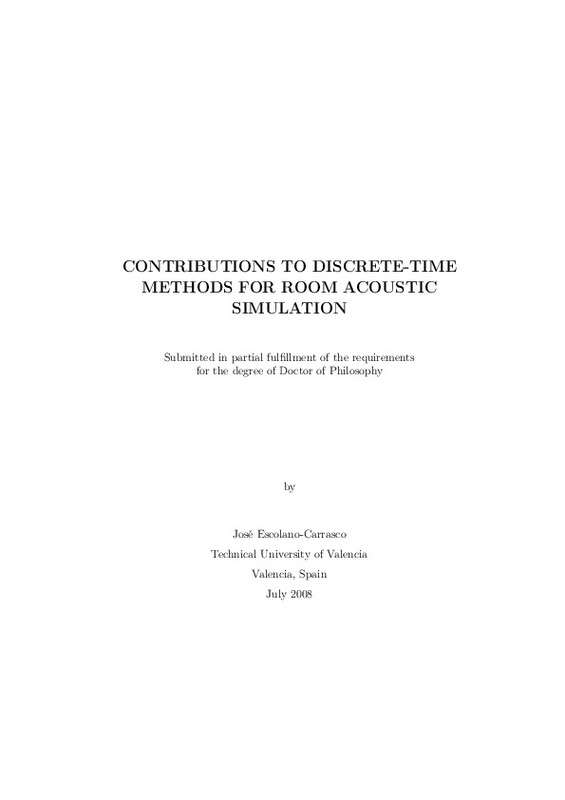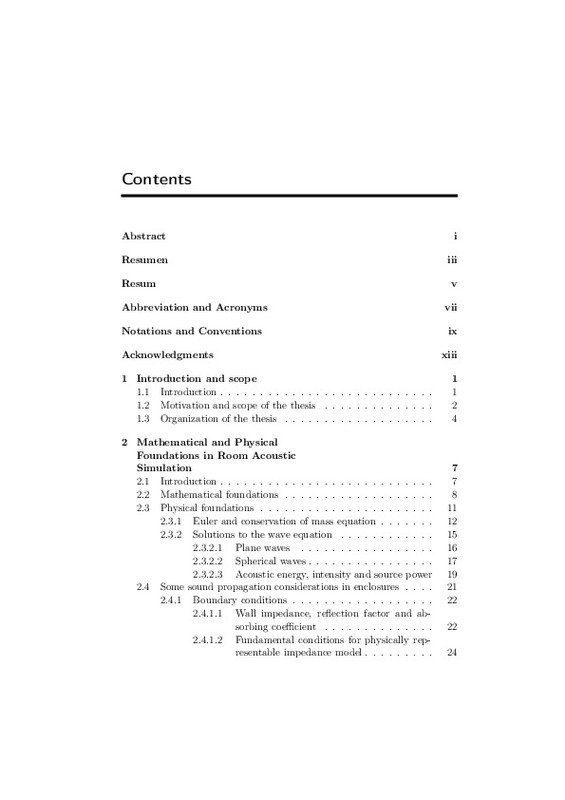- RiuNet repositorio UPV
- :
- Investigación
- :
- Tesis doctorales
- :
- Ver ítem
JavaScript is disabled for your browser. Some features of this site may not work without it.
Buscar en RiuNet
Listar
Mi cuenta
Estadísticas
Ayuda RiuNet
Admin. UPV
Contributions to discrete-time methods for room acoustic simulation
Mostrar el registro sencillo del ítem
Ficheros en el ítem
| dc.contributor.advisor | López Monfort, José Javier
|
es_ES |
| dc.contributor.author | Escolano Carrasco, José
|
es_ES |
| dc.date.accessioned | 2010-05-24T07:10:53Z | |
| dc.date.available | 2010-05-24T07:10:53Z | |
| dc.date.created | 2008-07-23T08:00:00Z | es_ES |
| dc.date.issued | 2010-05-24T07:10:50Z | es_ES |
| dc.identifier.uri | http://hdl.handle.net/10251/8309 | |
| dc.description.abstract | The sound field distribution in a room is the consequence of the acoustic properties of radiating sources and the position, geometry and absorbing characteristics of the surrounding boundaries in an enclosure (boundary conditions). Despite there existing a consolidated acoustic wave theory, it is very difficult, nearly impossible, to find an analytical expression of the sound variables distribution in a real room, as a function of time and position. This scenario represents as an inhomogeneous boundary value problem, where the complexity of source properties and boundary conditions make that problem extremely hard to solve. Room acoustic simulation, as treated in this thesis, comprises the algebraical approach to solve the wave equation, and the way to define the boundary conditions and source modeling of the scenario under analysis. Numerical methods provide accurate algorithms for this purpose and among the different possibilities, the use of discrete-time methods arises as a suitable solution for solving those partial differential equations, particularized by some specific constrains. Together with the constant growth of computer power, those methods are increasing their suitability for room acoustic simulation. However, there exists an important lack of accuracy in the definition of some of these conditions so far: current frequency-dependent boundary conditions do not comply with any physical model, and directive sources in discrete-time methods have been hardly treated. This thesis discusses about the current state-of-the-art of the boundary conditions and source modeling in discrete-time methods for room acoustic simulation, and it contributes some algorithms to enhance boundary condition formulation, in a locally reacting impedance sense, and source modelling in terms of directive sources under a defined radiation pattern. These algorithms have been particularized to some discrete-time methods such as the Finite Difference Time Domain and the Digital Waveguide Mesh. | en_EN |
| dc.language | Inglés | en_EN |
| dc.publisher | Universitat Politècnica de València | es_ES |
| dc.rights | Reserva de todos los derechos | es_ES |
| dc.source | Riunet | |
| dc.subject | Acústica arquitectónica | es_ES |
| dc.subject | Impedancia de reacción local | es_ES |
| dc.subject | Métodos en tiempo discreto | es_ES |
| dc.subject | Modelo de fuentes sonoras | es_ES |
| dc.subject | Problema no homogéneo de contorno | es_ES |
| dc.subject | Simulación acústica de salas | es_ES |
| dc.subject.classification | TEORIA DE LA SEÑAL Y COMUNICACIONES | es_ES |
| dc.title | Contributions to discrete-time methods for room acoustic simulation | |
| dc.type | Tesis doctoral | es_ES |
| dc.subject.unesco | 220102 - Acústica arquitectónica | es_ES |
| dc.subject.unesco | 3325 - Tecnología de las telecomunicaciones | es_ES |
| dc.subject.unesco | 120613 - Ecuaciones diferenciales en derivadas parciales | es_ES |
| dc.identifier.doi | 10.4995/Thesis/10251/8309 | es_ES |
| dc.rights.accessRights | Abierto | es_ES |
| dc.contributor.affiliation | Universitat Politècnica de València. Departamento de Comunicaciones - Departament de Comunicacions | es_ES |
| dc.description.bibliographicCitation | Escolano Carrasco, J. (2008). Contributions to discrete-time methods for room acoustic simulation [Tesis doctoral]. Universitat Politècnica de València. https://doi.org/10.4995/Thesis/10251/8309 | es_ES |
| dc.description.accrualMethod | Palancia | es_ES |
| dc.type.version | info:eu-repo/semantics/acceptedVersion | es_ES |
| dc.relation.tesis | 2874 | es_ES |
Este ítem aparece en la(s) siguiente(s) colección(ones)
-
Tesis doctorales [5389]







![Text file [Text]](/themes/UPV/images/text.png)


